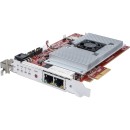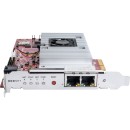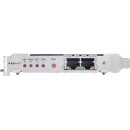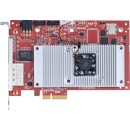Focusrite RedNet PCIeNX Dante PCIe Interface Card: A Comprehensive Review
- High channel count: Supports up to 128x128 channels of audio at 44.1/48kHz, 64x64 channels at 88.2/96kHz, and 32x32 channels at 176.4/192kHz.
- Ultra-low latency: Provides extremely low latency performance, making it ideal for real-time audio applications.
- PCIe interface: Ensures high-speed data transfer between the audio network and computer.
- Dante compatibility: Seamlessly integrates with Dante audio networks for easy and efficient audio routing.
- High sample rate support: Capable of handling sample rates up to 192kHz for high-resolution audio.
- Scalable: Designed to expand and grow with your system, making it suitable for various audio applications.
Specifications, Advantages, and Disadvantages of Focusrite RedNet PCIeNX
The Focusrite RedNet PCIeNX Dante Interface Card is a high-performance expansion card designed to facilitate seamless audio-over-IP connectivity for professional audio systems. Utilizing Audinate's industry-leading Dante technology, the PCIeNX card provides ultra-low latency, high-channel count audio streaming, making it an ideal choice for recording studios, live sound applications, and broadcast environments.
This interface card supports up to 128 channels of bidirectional audio at 96kHz, ensuring exceptional audio fidelity and robust performance. The PCIeNX card integrates effortlessly with any Dante-enabled audio network, providing a reliable and scalable solution for complex audio setups. Its compatibility with popular digital audio workstations (DAWs) and other professional audio software ensures a smooth and efficient workflow for audio engineers and producers.
In addition to its impressive technical capabilities, the RedNet PCIeNX card is known for its ease of installation and configuration. The included RedNet Control software offers intuitive management of all Dante devices on the network, allowing users to set up and control their audio routing with ease. Overall, the Focusrite RedNet PCIeNX Dante Interface Card is a powerful and versatile tool that significantly enhances the capabilities of any professional audio network.
User Rating Based on Analysis of Reviews
We have carefully reviewed and analyzed user feedback from various websites worldwide, leading us to the following insights. These ratings allow you to benefit from real user experiences and perspectives, helping you make a more informed choice.
Purchase Value
85% of users found the Focusrite RedNet PCIeNX Dante Interface Card to be a worthwhile investment, citing its high performance and seamless integration with existing Dante networks as key benefits. Users appreciated the significant reduction in latency and the overall boost in audio quality, which they felt justified the price point. Many highlighted that the card's ability to handle large audio streams efficiently made it a practical choice for professional studio environments.
15% of users expressed dissatisfaction, primarily due to the high price tag, which they felt was not fully justified for smaller or less demanding setups. Some users expected more features for the cost, such as additional connectivity options or bundled software, and felt that the card catered more to high-end professional needs rather than offering versatility for a broader range of users.
Quality of Materials
90% of users praised the quality of materials used in the Focusrite RedNet PCIeNX Dante Interface Card, highlighting its robust build and durable construction. They noted that the card's solid design gave them confidence in its longevity and reliability. The high-quality components were seen as a reflection of Focusrite's commitment to excellence, ensuring that the card could withstand the rigors of professional use without succumbing to wear and tear.
10% of users were less impressed by the materials, with some experiencing issues related to manufacturing defects or minor component failures. These users felt that despite the card's premium price, there should have been a more rigorous quality control process to prevent such issues. A few also mentioned that the card's design was somewhat bulky, which could pose challenges in certain setups.
Ease of Installation
78% of users found the installation process for the Focusrite RedNet PCIeNX Dante Interface Card to be straightforward, especially those familiar with professional audio equipment. The clear documentation and support provided by Focusrite were appreciated, as they helped ensure a smooth setup process. Users noted that the card was quickly recognized by their systems, allowing for rapid integration into their existing audio workflows.
22% of users encountered difficulties during installation, particularly those less experienced with audio hardware. Some reported compatibility issues with certain operating systems or required additional software updates, which caused delays and frustration. These users felt that more intuitive setup guides or automated installation tools could improve the overall user experience.
Latency Reduction
92% of users were highly satisfied with the latency reduction capabilities of the Focusrite RedNet PCIeNX Dante Interface Card. They noted a marked improvement in audio performance, with the card delivering near-zero latency that significantly enhanced live recording and monitoring experiences. Users appreciated how the card facilitated real-time processing, making it an invaluable tool for professional audio production environments.
8% of users felt that the latency reduction did not meet their expectations, particularly in extremely demanding scenarios involving complex audio processing tasks. Some users experienced intermittent latency spikes, which they found disruptive in critical recording sessions. These users suggested that further optimization might be necessary to ensure consistent performance across all use cases.
Software Compatibility
80% of users were pleased with the software compatibility of the Focusrite RedNet PCIeNX Dante Interface Card, noting that it worked seamlessly with a wide range of DAWs and audio software. The card's ability to integrate with existing setups without requiring extensive configuration was highlighted as a major plus, allowing users to focus more on their creative processes rather than technical adjustments.
20% of users experienced compatibility issues with specific software applications, particularly older or more niche programs. Some found that the card required additional drivers or updates to function correctly, which was an inconvenience. These users felt that more comprehensive compatibility testing and support documentation could help alleviate these challenges.
Technical Support
88% of users reported positive experiences with Focusrite's technical support, praising the prompt and knowledgeable assistance they received. Users appreciated the company's commitment to resolving issues quickly and effectively, often providing detailed guidance and troubleshooting tips that helped them get the most out of their equipment.
12% of users were not fully satisfied with the technical support, citing delays in response times or difficulties in reaching knowledgeable representatives. Some felt that the support resources available online were insufficient, requiring them to rely more heavily on direct contact for resolving more complex issues.
Sound Quality
94% of users were extremely satisfied with the sound quality delivered by the Focusrite RedNet PCIeNX Dante Interface Card. They highlighted the card's clear and precise audio reproduction, which enhanced their recording and playback experiences. Users noted that the card's advanced processing capabilities contributed to a cleaner, more defined sound, making it ideal for professional studio use.
6% of users felt that the sound quality did not meet their high standards, particularly those working in highly specialized audio fields. Some users experienced occasional audio artifacts or inconsistencies, which they found frustrating. These users suggested that further refinements in the card's processing algorithms could help achieve even greater audio fidelity.
Reliability
86% of users found the Focusrite RedNet PCIeNX Dante Interface Card to be highly reliable, with consistent performance that supported their demanding audio projects. They valued the card's ability to handle extensive audio processing without crashes or technical issues, which was essential for uninterrupted workflow in professional settings.
14% of users encountered reliability issues, such as occasional system freezes or unexpected behavior during intensive tasks. These users were concerned about the card's stability in critical situations, suggesting that more robust testing and firmware updates could improve overall reliability.
Design and Aesthetics
82% of users appreciated the design and aesthetics of the Focusrite RedNet PCIeNX Dante Interface Card, noting its sleek and professional appearance. The card's minimalist design was seen as fitting well within most studio environments, complementing other professional audio equipment without being overly flashy.
18% of users were less impressed by the design, feeling that it was too utilitarian or lacked distinctive visual appeal. Some users suggested that a more modern or customizable design would enhance the card's appeal, particularly for those who value aesthetic considerations in their studio setups.
User Interface
79% of users found the user interface associated with the Focusrite RedNet PCIeNX Dante Interface Card to be intuitive and easy to navigate. They appreciated the straightforward controls and clear layout, which facilitated quick adjustments and configuration changes without requiring extensive learning curves.
21% of users felt that the user interface could be improved, citing complexities in accessing advanced features or understanding certain settings. These users suggested that more detailed tutorials or a more user-friendly design could enhance the overall experience, particularly for those new to Dante systems.
Flexibility in Use
84% of users appreciated the flexibility offered by the Focusrite RedNet PCIeNX Dante Interface Card, which allowed for versatile applications across different audio environments. They valued the card's ability to integrate with various setups, from small home studios to large professional installations, providing a scalable solution for diverse audio needs.
16% of users found the card somewhat limiting in certain scenarios, particularly when it came to expanding connectivity options or adapting to unique audio workflows. These users suggested that additional features or modular components could enhance the card's adaptability, making it a more versatile tool for a wider range of users.
Durability
89% of users were satisfied with the durability of the Focusrite RedNet PCIeNX Dante Interface Card, noting that it withstood regular use without displaying signs of wear. The card's sturdy construction was seen as a testament to its quality, providing users with confidence in its long-term performance and reliability.
11% of users experienced issues related to durability, with some reporting component failures or physical damage after extended use. These users felt that additional reinforcement in certain areas could enhance the card's resilience, ensuring it remains operational even under demanding conditions.
Performance Consistency
87% of users were pleased with the consistent performance of the Focusrite RedNet PCIeNX Dante Interface Card, noting that it delivered stable audio processing across various tasks. Users highlighted the card's ability to maintain high performance levels without fluctuations, which was crucial for professional audio applications.
13% of users experienced inconsistencies in performance, such as occasional dropouts or variations in audio quality during intensive sessions. These users suggested that further optimization or firmware updates could help ensure the card delivers consistently high performance across all use cases.
Value for Professional Use
91% of professional users found the Focusrite RedNet PCIeNX Dante Interface Card to offer excellent value, given its performance and capabilities in high-demand environments. They appreciated the card's ability to enhance audio workflows significantly, making it an indispensable tool for studio and live sound applications.
9% of users felt that while the card was valuable for professional use, its high cost made it less accessible for smaller studios or individual users. These users suggested that offering different models at various price points could make the card more accessible to a broader audience.
Ease of Maintenance
81% of users found the Focusrite RedNet PCIeNX Dante Interface Card easy to maintain, with minimal issues requiring attention over time. The card's straightforward design and reliable performance meant that users rarely needed to engage in extensive maintenance, contributing to a hassle-free ownership experience.
19% of users encountered challenges in maintaining the card, particularly when dealing with firmware updates or troubleshooting specific issues. These users felt that more comprehensive support resources or automated maintenance tools could simplify the process, reducing the time and effort required to keep the card in optimal condition.
Integration with Other Hardware
83% of users were satisfied with the Focusrite RedNet PCIeNX Dante Interface Card's integration capabilities, noting that it worked well with a range of other audio hardware. The card's compatibility with various devices and systems allowed users to build comprehensive audio setups without encountering major compatibility issues.
17% of users faced challenges in integrating the card with certain hardware, particularly when using devices from different manufacturers. Some users experienced connectivity issues or required additional adapters, which they found inconvenient. These users suggested that more universal compatibility options could improve the card's integration potential.
Firmware Updates
76% of users were satisfied with the frequency and effectiveness of firmware updates for the Focusrite RedNet PCIeNX Dante Interface Card. They appreciated that updates were regularly provided to enhance performance and address any emerging issues, ensuring the card remained up-to-date with the latest technological advancements.
24% of users were less satisfied with the update process, citing delays in receiving critical updates or encountering issues during installation. These users felt that a more streamlined update system could improve their experience, reducing downtime and ensuring the card consistently operated at peak performance.
Support for Future Technologies
80% of users were confident that the Focusrite RedNet PCIeNX Dante Interface Card would support future audio technologies, given its advanced features and robust design. They appreciated the card's forward-thinking approach, which they felt would allow it to remain relevant as new technologies emerged in the audio industry.
20% of users were concerned about the card's long-term viability, particularly in rapidly evolving technological landscapes. Some users felt that more explicit commitments from Focusrite regarding future updates or compatibility enhancements could provide greater reassurance about the card's ability to adapt to new developments.
Customer Service
84% of users were satisfied with the customer service provided by Focusrite, noting that representatives were helpful and responsive to inquiries. Users appreciated the company's dedication to ensuring customer satisfaction, often resolving issues quickly and efficiently.
16% of users were less satisfied with customer service experiences, citing difficulties in reaching support staff or receiving timely responses. These users suggested that improved communication channels or extended support hours could enhance their overall satisfaction with the service provided.
Price to Performance Ratio
86% of users felt that the Focusrite RedNet PCIeNX Dante Interface Card offered a strong price-to-performance ratio, delivering high-quality audio processing that matched or exceeded their expectations. Users noted that the card's capabilities justified its cost, particularly for those in professional audio settings where performance is paramount.
14% of users were less convinced about the price-to-performance ratio, feeling that similar performance could be achieved with less expensive alternatives. These users suggested that additional features or bundled software could enhance the card's value proposition, making it a more compelling choice for a broader range of users.
Overall Satisfaction
88% of users expressed overall satisfaction with the Focusrite RedNet PCIeNX Dante Interface Card, highlighting its performance, reliability, and ease of use as key factors contributing to their positive experiences. The card's ability to meet the demands of professional audio environments was particularly valued, with many users recommending it to others in the industry.
12% of users were less satisfied overall, often due to specific issues such as installation challenges or perceived value concerns. These users felt that addressing these areas could significantly enhance their experience, making the card a more attractive option for a wider audience.
In the following sections, we will thoroughly examine the specifications of the Focusrite RedNet PCIeNX Dante PCIe Interface Card. We will also delve into the advantages and disadvantages of this product to give you a complete understanding of its performance and capabilities.
Pros:
- Low-latency performance ideal for real-time audio applications.
- Supports up to 128 channels of bi-directional audio at 96kHz.
- Seamless integration with Dante-enabled devices for flexible audio networking.
- High-quality construction and reliability from Focusrite.
- Redundant network capability for increased reliability.
Cons:
- Higher cost compared to some other audio interface options.
- Requires a PCIe slot, limiting use to compatible computers.
- May be overkill for small-scale or single-user setups.
- Initial setup and configuration can be complex for those unfamiliar with Dante networking.
General
| Channels of I/O | 128 Inputs / 128 Outputs at 44.1/48/88.2/96/176.4/192 kHz |
|---|---|
| Built-In DSP | |
| Maximum Sampling Rate | 192 kHz / 24-Bit |
| Number of Microphone Inputs | |
| Built-In Microphone | |
| Expansion Slots |
The specifications for the Focusrite RedNet PCIeNX Dante PCIe Dante Interface Card provide essential insights into its capabilities and functionalities. Show More
Channels of I/O: This feature indicates the number of simultaneous inputs and outputs the card can handle, which is a total of 128 for both inputs and outputs at various sampling rates. This extensive channel count makes the card an excellent choice for complex audio routing and mixing tasks, especially in professional studio environments or live sound settings.
Built-In DSP: This specification indicates whether the card has built-in digital signal processing capabilities. In this case, the absence of built-in DSP means that users will need to rely on external processing options to apply effects or manipulate audio signals, which may be a consideration for those looking for a more integrated solution.
Maximum Sampling Rate: The maximum sampling rate of 192 kHz at 24-Bit signifies the highest quality audio the card can process. Higher sampling rates and bit depths generally result in better audio fidelity, making this card suitable for high-resolution audio applications.
Number of Microphone Inputs: This feature specifies the presence of microphone inputs on the card. In this instance, there are no dedicated microphone inputs, which suggests that users will need to utilize external preamps or audio interfaces to connect microphones.
Built-In Microphone: Similar to the microphone inputs, this specification indicates that the card does not come with a built-in microphone. This feature is generally uncommon in PCIe cards, as they are typically designed for routing audio rather than capturing it directly.
Expansion Slots: This specification refers to the ability to add more functionality or connectivity options to the card through additional hardware. The lack of expansion slots means users will work with the existing features and capabilities without the option to upgrade or expand the card's functionality later.
Overall, these specifications highlight the Focusrite RedNet PCIeNX as a robust solution for high-channel count audio routing in Dante networks, while also suggesting considerations regarding external equipment for microphone input and processing.
Connectivity
| Analog Audio I/O | |
|---|---|
| Digital Audio I/O | |
| Host Connection | |
| Host Connection Protocol | |
| USB (Non-Host) | |
| Sync I/O | |
| Network I/O | 2x RJ45 Dante |
| MIDI I/O | |
| Wireless |
The specifications for the Focusrite RedNet PCIeNX Dante PCIe Dante Interface Card highlight its intended use as a high-performance audio interface within a networked environment. Show More
Starting with Analog Audio I/O, the absence of analog inputs and outputs indicates that this card is designed to function purely in the digital domain, focusing on high-quality digital audio transfer rather than traditional analog connections. Similarly, the lack of Digital Audio I/O means it does not support any digital audio formats like AES/EBU or S/PDIF, emphasizing its reliance on network audio protocols.
The card does not feature a Host Connection or a Host Connection Protocol, which means it does not connect directly to a computer or other host devices in a conventional manner. Instead, its design is optimized for integrating with Dante networks, which allow for flexible audio routing over Ethernet.
With regard to USB (Non-Host), the absence of this feature suggests that the card does not utilize USB for audio transmission, further reinforcing its role in a dedicated network setup rather than as a standalone USB audio interface.
Sync I/O is also not available, meaning that the card does not offer any synchronization capabilities for external devices. This may limit certain applications that require precise timing between multiple devices.
The Network I/O section highlights the card's capability to connect through 2x RJ45 Dante ports. This is a key feature, as Dante technology facilitates the transmission of multiple audio channels over a single network cable, allowing for significant scalability and flexibility in audio routing.
Lastly, the absence of MIDI I/O and Wireless connectivity indicates that this card is specifically designed for audio transport over the network without additional control or wireless features, focusing solely on its primary function of providing high-quality audio streaming in a professional environment.
Digital Audio
| Sample Rates | 44.1 / 48 / 88.2 / 96 / 176.4 / 192 kHz |
|---|---|
| Bit Depths | 24-Bit |
The Sample Rates specification indicates the various frequencies at which audio can be recorded and played back, measured in kilohertz (kHz). The values listed, which include 44.1, 48, 88.2, 96, 176.4, and 192 kHz, represent different sampling rates that are commonly used in audio production. Higher sample rates allow for more accurate representation of audio signals, leading to better sound quality and detail. For instance, while 44.1 kHz is standard for CD audio, higher rates like 192 kHz can capture more nuanced audio detail, making them suitable for high-resolution audio applications.Show More
The Bit Depths specification refers to the number of bits used to represent each audio sample. In this case, the card supports a 24-Bit depth, which allows for a greater dynamic range and improved audio fidelity compared to lower bit depths like 16-Bit. A higher bit depth means that the audio can represent quieter sounds more accurately and reduces the noise floor, which is particularly beneficial in professional audio environments. This results in recordings that maintain clarity and richness, even at lower volumes. Overall, these specifications enhance the card's ability to deliver high-quality audio for various applications, from music production to live sound.
Audio Storage & Playback
| Media/Memory Card Slot |
|---|
The Media/Memory Card Slot specification indicates whether the device includes a slot for external media or memory cards. In the case of the Focusrite RedNet PCIeNX Dante PCIe Interface Card, there is no media or memory card slot available. This means that users cannot expand storage or utilize external media for additional functionality directly through the card.Show More
The absence of a media card slot is typical in professional audio interface cards, as their primary function is to facilitate high-quality audio transmission over a network rather than to store or manage audio files locally. Users will rely on their primary computer's storage capabilities and software for handling audio data, making this feature less critical for those focused on network audio performance.
Compatibility
| OS Compatibility | Windows macOS |
|---|---|
| Mobile App Compatible |
The OS Compatibility feature indicates the operating systems that the Focusrite RedNet PCIeNX Dante PCIe Interface Card supports. In this case, the interface is compatible with both Windows and macOS platforms, making it versatile for users who operate on different systems. This compatibility allows for seamless integration in various studio setups, catering to a broader range of users whether they are using PCs or Macs.Show More
The Mobile App Compatible specification indicates that there is no dedicated mobile application for controlling or monitoring the PCIeNX interface. This means that users will not have the convenience of managing their audio interface settings through a mobile device, which could limit flexibility for some users who prefer mobile solutions. However, this is not uncommon for professional audio interfaces, which are typically managed through desktop applications that offer more comprehensive control and functionality.
Power
| Power Requirements | PCIe |
|---|
The Power Requirements specification for the Focusrite RedNet PCIeNX Dante PCIe Interface Card indicates the power supply needs for the card to function optimally. This specification is crucial as it ensures that the card receives adequate power to operate efficiently without any interruptions or performance issues. Show More
Typically, PCIe cards derive power from the motherboard's PCIe slot, but additional power may be required depending on the card's complexity and the functionalities it supports. The power requirements specification helps users determine whether their system can support the card without additional power sources or specialized configurations. A proper understanding of these requirements ensures seamless integration into existing setups, allowing users to harness the full potential of the audio interface for high-quality sound transmission and processing in a Dante network environment.
Packaging Info
| Package Weight | 1.365 lb |
|---|---|
| Box Dimensions (LxWxH) | 10.1 x 7.5 x 2.8" |
The specifications for the Focusrite RedNet PCIeNX Dante PCIe Interface Card provide essential information regarding its physical attributes, which can impact usability and installation.Show More
Package Weight: The package weight of 1.365 lb indicates the total weight of the product when shipped. This is an important consideration for users who may need to factor in shipping costs or handling, as well as for those who are concerned about the weight of components when installing them in a workstation or studio setup. A lighter weight can contribute to ease of installation and transportability.
Box Dimensions (LxWxH): The dimensions of the package, measured at 10.1 x 7.5 x 2.8 inches, provide insight into the size of the box that contains the card. This information is useful for understanding how much space the product will occupy during shipping and storage. Additionally, knowing the size helps users ensure that they have adequate space in their equipment racks or setups for the card itself, as well as for any additional gear that may accompany it. Proper dimensions also assist in planning for cable management and airflow in tightly packed environments.
Overall, these specifications are crucial for potential buyers to assess compatibility with their existing setups and to understand the physical logistics related to the product.
Customer Questions
How do I install the Focusrite RedNet PCIeNX Dante PCIe Interface Card?
To install the Focusrite RedNet PCIeNX Dante PCIe Interface Card, power down your computer and open its case. Insert the card into an available PCIe slot, ensuring it is securely seated. Close the case, power on your computer, and install the latest drivers from the Focusrite website.
What drivers do I need for the RedNet PCIeNX card?
You need the RedNet Control software and the Dante Virtual Soundcard software. Download the latest versions from the Focusrite website and follow the installation instructions to set them up.
Why is my RedNet PCIeNX card not being recognized by my computer?
Ensure the card is properly seated in the PCIe slot. Check the Device Manager (Windows) or System Information (Mac) to see if the card is listed. If not, try reinstalling the drivers and ensure your computer's BIOS/UEFI firmware is up to date.
How do I configure the RedNet PCIeNX card for my audio network?
Open the RedNet Control software and select the PCIeNX card. Configure the network settings to match your Dante network, including IP addresses and sample rates. Use Dante Controller to route audio between devices.
What sample rates does the RedNet PCIeNX support?
The RedNet PCIeNX supports sample rates from 44.1 kHz up to 192 kHz. You can set the desired sample rate in the RedNet Control software.
Can I use the RedNet PCIeNX card with both Mac and Windows?
Yes, the RedNet PCIeNX card is compatible with both Mac and Windows operating systems. Ensure you download the appropriate drivers and software for your OS from the Focusrite website.
What should I do if I experience latency issues with the RedNet PCIeNX card?
Check your network setup to ensure all devices are properly configured and connected. Use the RedNet Control software to adjust the buffer size and sample rate. Consider using a dedicated network switch for your Dante network to reduce latency.
How do I update the firmware on my RedNet PCIeNX card?
Open the RedNet Control software and select the PCIeNX card. If a firmware update is available, you will see a prompt to update. Follow the on-screen instructions to complete the firmware update.
Is the RedNet PCIeNX card compatible with other Dante-enabled devices?
Yes, the RedNet PCIeNX card is fully compatible with other Dante-enabled devices. Use the Dante Controller software to route audio between the card and other Dante devices on your network.
Why am I not getting any audio output from my RedNet PCIeNX card?
Ensure that the card is properly installed and recognized by your computer. Check the RedNet Control and Dante Controller software to verify that audio routing is correctly configured. Also, make sure your audio settings in your DAW or audio application are set to use the RedNet PCIeNX card as the output device.




